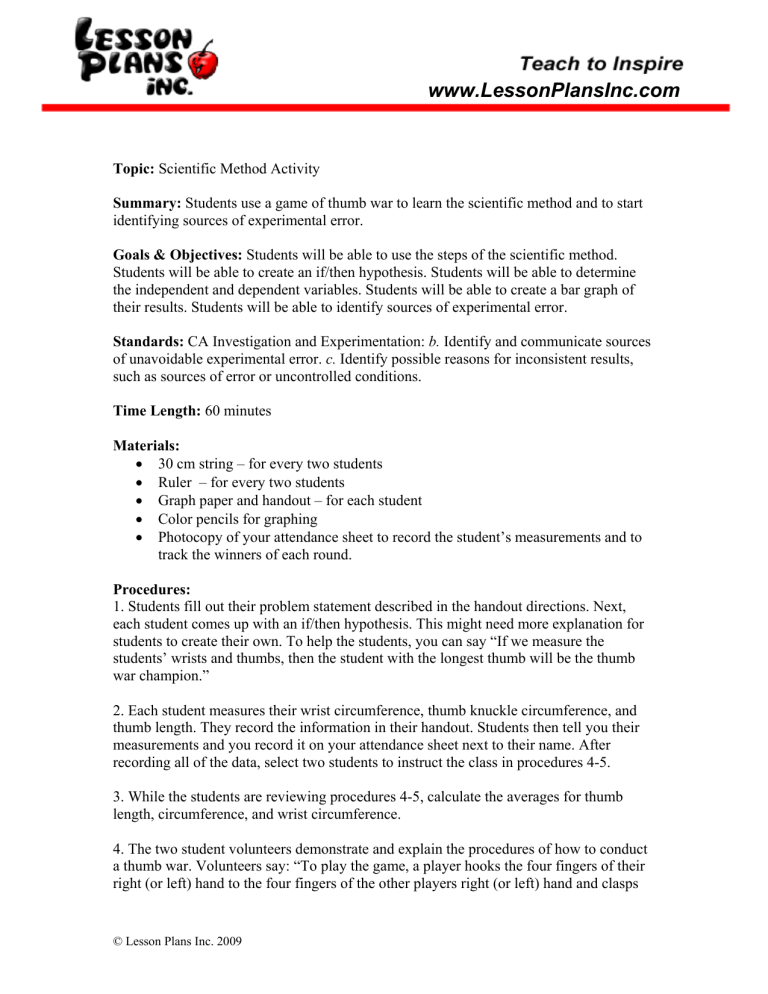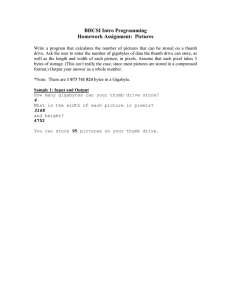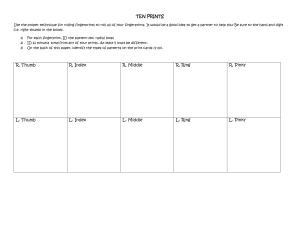
www.LessonPlansInc.com Topic: Scientific Method Activity Summary: Students use a game of thumb war to learn the scientific method and to start identifying sources of experimental error. Goals & Objectives: Students will be able to use the steps of the scientific method. Students will be able to create an if/then hypothesis. Students will be able to determine the independent and dependent variables. Students will be able to create a bar graph of their results. Students will be able to identify sources of experimental error. Standards: CA Investigation and Experimentation: b. Identify and communicate sources of unavoidable experimental error. c. Identify possible reasons for inconsistent results, such as sources of error or uncontrolled conditions. Time Length: 60 minutes Materials: • 30 cm string – for every two students • Ruler – for every two students • Graph paper and handout – for each student • Color pencils for graphing • Photocopy of your attendance sheet to record the student’s measurements and to track the winners of each round. Procedures: 1. Students fill out their problem statement described in the handout directions. Next, each student comes up with an if/then hypothesis. This might need more explanation for students to create their own. To help the students, you can say “If we measure the students’ wrists and thumbs, then the student with the longest thumb will be the thumb war champion.” 2. Each student measures their wrist circumference, thumb knuckle circumference, and thumb length. They record the information in their handout. Students then tell you their measurements and you record it on your attendance sheet next to their name. After recording all of the data, select two students to instruct the class in procedures 4-5. 3. While the students are reviewing procedures 4-5, calculate the averages for thumb length, circumference, and wrist circumference. 4. The two student volunteers demonstrate and explain the procedures of how to conduct a thumb war. Volunteers say: “To play the game, a player hooks the four fingers of their right (or left) hand to the four fingers of the other players right (or left) hand and clasps © Lesson Plans Inc. 2009 www.LessonPlansInc.com firmly. To start the game both students say ‘One, two, three, four, I declare a thumb war.’ Both students try to trap, pin, or capture the opponent's thumb for three seconds to win. Females play females and males play males. Students can conduct only one thumb war per round.” 5. The two volunteers explain the rules to help prevent cheating. Volunteers say: “Use of the index finger to sweep over the opponent's thumb in not allowed. Twisting the opponent's arm or wrist to gain leverage is not allowed. Use of the opposite hand is not allowed. When the thumb is pinned, the counting should be at the same speed. Students should not apply too much pressure or force, in order to avoid hurting the opponent.” 6. When students determine the winner, they come to you and tell you who won. You indicate the results on the attendance sheet and select two winning students to play in the next round. The students who lose may socialize and watch the next round. 7. At the end of the tournament, you will have two champions, one male and one female. Write the two winners names on the board. Write the average totals for the class on the board or overhead. Students independently now fill out the analysis and the conclusion. 8. Students will create a bar graph with the wrist, thumb length, and thumb circumference of male winner, female winner and the class average as the IV (independent variable) and 0-30 centimeters as the DV (dependent variable). The legend should have male winner, female winner and the class average as the categories. Accommodations: Students who are not able to participate or are not willing to participate in a thumb war can do rock, paper, scissors instead. Student with physical limitations can perform your duties: recording measurements onto the attendance sheet, calculating the averages, or selecting students to compete in each of the rounds. Students with an IEP can take the handout home if they need extra time. They can also graph one winner instead of both and tally the class average. Evaluation: Problem statement, hypothesis, materials, data, and conclusion are worth 5 points each, for a total of 25 points. The graph is worth a total of 10 points with each part worth 5 points: (title, x y axis, and labels), correct IV and DV values with legend. This assignment is worth a total of 35 points. © Lesson Plans Inc. 2009 Name: _______________________ Row: _______ Date:_____________ Period:______ Scientific Method - Thumb Wrestling Observation / Question: What makes someone a good thumb wrestler? Hypothesis: If _________________________________________________________________, then ____________________________________________________________________________. Materials: _______________ _____________________ ________________ _______________ Your measurements - Wrist: ________ Thumb circumference: ________ Thumb length: _________ Procedures: To play the game, a player hooks the four fingers of their right (or left) hand to the four fingers of the other players right (or left) hand and clasps firmly. Both students try to trap, pin, or capture the opponent's thumb for three seconds to win. Females play females and males play males. Students can conduct only one thumb war per round. No cheating! Twisting the opponent's arm, use of the opposite hand, or use of the index finger is not allowed. When the thumb is pinned, the counting should be at the same speed. Students should not hurt other students. Variables: Independent variables (IV) list: _________________________________________ Dependent variable (DV): _____________________________ Controlling variables list: _______________________________________________________ Experiment Data: Male winner: Wrist: _________ Thumb circumference: _________ Thumb length: _______ Female winner: Wrist: _________ Thumb circumference: _________ Thumb length: _____ Class average: Wrist: _________ Thumb circumference: _________ Thumb length: _______ Analysis: Create a bar graph with the wrist, thumb length, and thumb circumference as the IV and 0-25 centimeters as the DV. The legend should have male winner, female winner and the class average as the categories. There will be nine bars. Conclusion: What trait was the most important for winning? __________________ Did you have the same conclusion as all the other students in the class? ________ What were the experimental errors in this lab? _______________________________________ _____________________________________________________________________________ Why did having 3 independent variables cause the class to have inconsistent conclusions? _____________________________________________________________________________ Why is it important to identify sources of experimental errors or uncontrolled conditions? _____________________________________________________________________________ _____________________________________________________________________________ _____________________________________________________________________________ © Lesson Plans Inc. 2009


